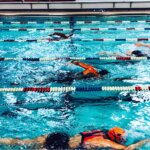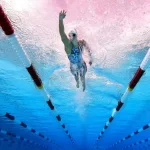Triathlon is an expensive sport. According to a 2014 study conducted by USA Triathlon, the average annual amount spent per triathlon (if you need to purchase a bike) is $4,000. The breakdown of those costs include:
- $2,798 spent on bikes and bike equipment
- $564 spent on race fees
- $370 spent on training, running and athletic footwear
- $277 spent on nutritional supplements
But not all of us have pockets full of money to throw at our hobby. So here are some quick tips to help you handle the cost of triathlons:
Swimming
- Goggles should not be terribly expensive. There is no reason to spend more than $20 on goggles. Most goggles will last an entire season and even longer if you take care of them. It’s a good idea to have at least 2 pair in case one breaks just before a race.
- A Pool/Place to Swim – The “free” option is go find a lake or ocean and go swimming. But if you live in a climate where lakes freeze over, you need an indoor pool. Most health clubs and park districts cost money for membership. Adding an additional family member helps offset the membership costs. Be sure to look into masters swim teams near you. A complete list of locations can be found here: USMS.org. One other option can be open swim times at your local high school. Many high schools have lap swimming available to community members for free or a nominal charge.
- Wetsuit – you only need a wetsuit if the water is going to be very cold. However, the buoyancy offered by the wetsuit is unmatched and is incredibly helpful. To save money on a wetsuit, buy second hand and check Amazon. A wetsuit should last you many seasons if you take care of it properly. Not sure if you need one? Some triathlon shops will let you rent a wetsuit and even apply that rental fee toward the purchase of a wetsuit. If you’re looking to rent a wetsuit before purchasing, check out Urban Tri Gear.
Biking
- Bicycle – Prices on bikes can range from an entry-level road bike for $500 on up to a fancy carbon triathlon bike with electronic shifting for $9000 or more. The good news is, you can buy a lower-end bike and each year, upgrade a component. Additionally, you can consider a used bike. You can find many excellent deals as people who started the sport a year or two before you decide to purchase new bikes. Lastly, the best time of year to purchase a bike is in the fall/winter. Just like cars, bike shops are anxious to get last year’s models out the door and slash prices. The most important thing when considering a new bike is to make sure it is the right size for you.
- Repairs – Not only is it important to learn how to change a flat tire to save your race or training ride, but it also saves money. You can change and replace your tires, clean your bike, adjust your derailleurs and adjust your brakes. The more you can know about how to take care of your bike, the more money you can save. There are certainly repairs that are best left up to the experts, but it is important to learn the basics of bike maintenance.
Running
- Shoes – This is one area you don’t want to skimp. Running in an improper shoe will cost you more money on physical therapy if you become injured, not to mention take you away from training and racing for a while. Go to a running specialty store to learn the correct shoe for you. Good running shoes will cost between $120-160 and last between 300-500 miles if you take care of them properly. Price still too steep? Most running stores will give you a discount if you belong to a triathlon team, running club or even health club. Looking for a place to get fit for running shoes? Check out Running for Kicks and get 10% off for mentioning this article!
- Treadmill – treadmills are convenient, but expensive (unless you already have a gym membership). If not, again, finding a used treadmill is the way to go. Good treadmills have a very long life when taken care of properly.
Gadgets, Accessories, and Coaching – Let’s talk about whether all the extra stuff is necessary to get through the swim, bike and run.
- Gadgets – The gadgets are cool and might include power meters, sport watches, heart rate monitors etc. The best way to save some money is to buy last year’s model. Certainly, the new models may have additional features, but it will cost you hundreds of additional dollars. Worth it? Probably not. Do your research and seek out the tools you really need.
- Accessories – included in this category are elastic laces, aero helmets, race wheels, and on-bike hydration systems. Always look for sales when purchasing any type of accessory. Race wheels are really expensive, but can save you time. You can rent wheels on race day for under $200. Perhaps this is something you consider for one of your important races and see if it makes a difference in your performance before you make that large purchase.
- Coaching – sometimes training on your own is difficult and hiring a trainer is worth the money. Hiring the right coach can save you time and money. Although hiring a coach is not an absolute must, a coach can help direct you on what you need to buy and many coaches have developed relationships with local retailers and industry leaders that offer discounts to their coaching clients. If one-on-one coaching is just not an option, look into a group class to save money.
You don’t have to re-mortgage your home or dip into your savings to train or enter a triathlon. If you use these cost savings measures, you will save money and have just as much fun!
Need help training or want more tips? Contact me today so I can help you reach your training goals!






